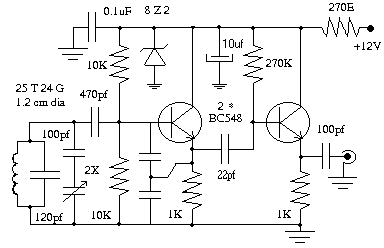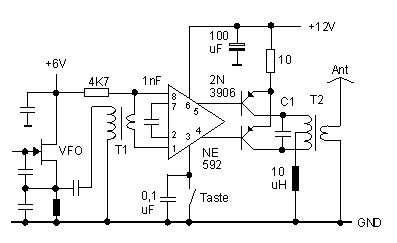As is common on LF, I usually run high power on 136 kHz (400 watts). But, in May 2001, I started wondering whether the 136 kHz band would be suitable for low power operation (i.e. operating with a TX power output of just 5 watts). It certainly seemed unlikely because of the poor antenna efficiency achievable at a wavelength of 2200 m, when using an antenna just a few tens of metres in length.
But I decided to build a QRP TX for LF, and give it a try! The Marathon LF TX to be described uses: a FET VFO; FET buffer; 2N2222 amplifier + BC212 keying transistor; 2SC2166 driver; and a pair of 2SC2166 transistors in parallel.On the first morning of operation, I made three QSOs using this little TX. None of the QSOs was pre-arranged. The first contact was with Tom G3OLB in Devon - 97 km away. I was so excited that it was hard for me to maintain control of the morse key! But I managed to rattle out Tom's 599 report, and was surprised and delighted to receive my 569 report from Tom. After my QSO with Tom, I worked G3YXM (105 km) and G8IK (101 km) - all using 5 watts RF to my simple 12 m vertical (no top loading). One week later, I worked John G4CNN (Caversham, Berkshire) for my best QRP DX, at 122 km.I believe that a simple low power transmitter for 136 kHz would make an excellent club project, with the very real prospect of not just making LF QSOs across town - but over significant distances too!
VFO
The 50 pF tuning capacitor provides a tuning range of 10 kHz - enough to cover the 135.7-137.8 kHz amateur band, and yet also act as a useful source when 'searching' for antenna resonance, or measuring antenna bandwidth. The VFO drives a very effective FET buffer which presents the VFO signal to the driver stages. (For improved voltage stabilisation, see the section 'Updates & feedback from other constructors' below.)
4.7 mH RF chokes work very well in this circuit. In the UK, suitable RF chokes may be obtained from Maplin (light green body, 50 ohms DC resistance, of rather poor construction which is prone to failure) and Sycom (brown body, 25 ohms DC resistance, of robust construction).

PRE-DRIVER
The pre-driver stage uses an untuned 2N2222 common emitter amplifier, keyed by a BC212 PNP transistor. In my experience, many QRP TX designs fail to provide adequate shaping of the keying waveform. To reduce the likelihood of transmitting key clicks, the keying circuit in the Marathon provides a rise time of 3 ms, and a fall time of 6 ms. The result is a very pleasant T9 note.
DRIVER
The keyed signal is coupled via a 0.1 uF capacitor to the 2SC2166 driver transistor. The gain of this stage is set by the 1200 ohm feedback resistor. For some brands of 2SC2166, you may need to increase the gain of this stage by increasing the feedback resistor to 4700 ohms. The drive level to the PA transistors is set by adjusting the emitter resistor, Rx. If variable output power is required, a variable resistor of 250 ohms may be used in place of Rx. The driver transformer, T1, is wound on a 25 mm OD 3C85 ring core, which has been found to provide excellent characteristics in LF transformer applications. An alternative core material is 3C90.

PA
The PA uses two 2SC2166 transistors connected in parallel. Rx in the driver stage should be set so that, on key down, each PA transistor draws 600 mA. This can be checked by measuring the voltage across one of the 1 ohm emitter resistors: 600 mV corresponds to a current of 600 mA. To reduce the PA emitter current, increase the value of Rx in the Driver stage. The gain of the PA is set by the 470 ohm resistor. For some brands of 2SC2166, you may need to increase the gain of this stage by increasing the 470 ohm resistor to 1200 ohms. The PA transistors will require a heatsink. Note that the tab of the 2SC2166 is internally connected to the collector, so be sure to use an insulating kit!
The PA transformer, T2, uses a 25 mm OD 3C85 ring core.

Construction
Because the VFO runs at the TX output frequency, some 'pulling' of the VFO frequency might be expected on key down. The degree of VFO shift will depend upon output power, and the magnetic coupling between the VFO coil and T2/L1/L2. This effect can be minimised, through effective screening between the VFO and the PA; and single-point earthing of all stages. The use of ring cores for L1 and L2 would also help (see 'Constructing the low pass filter inductors' below).Those with lots of experience of building homemade rigs will have no trouble building the Marathon into a smart equipment case.
Those with less experience would, perhaps, benefit by starting with a simpler approach. A prototype version can be constructed quickly on copper clad board using 'ugly construction' techniques. For such an approach, start by fixing some off-cuts of copper clad board to a piece of wood or 'chipboard'. (Prior to fitting the copper-clad board, be sure to remove any oxidation using metal polish, followed by a rinse with soap and water.) Odd scraps of aluminium sheet, or lids from tobacco, confectionery or biscuit tins can be used as the front and rear panels by screwing them to the front and back edges of the chipboard. Start by getting the tuning capacitor; antenna sockets; TX/RX switch; NET switch; 12 v connector; and PA transistors/heatsink mounted in convenient positions, and in relation to their position in the circuit diagram.
The rest is easy: solder those components needing a connection to earth directly to the copper-clad board; and solder the remaining components directly to one another. Don't worry too much about lead lengths; but be sure to provide enough spacing between components to prevent short circuits, and to allow voltage measurements to be made during testing. To support larger components, high value resistors can be soldered to earth at one end, and the other end to the component - a sort of poor man's 'insulated' terminal post. The bird's nest in the picture below worked just fine!

For more information about ugly construction techniques, click here.
Constructing the low pass filter inductors


L1 and L2 are 55 uH inductors, wound on separate formers and mounted at 90 degrees to each other. For each coil former, I used a 50 mm length of 22 mm outside diameter PVC pipe, purchased from a plumber's merchant. (Note that such pipe is often identified by its internal diameter, rather than its outside diameter.) The coil was wound with wire salvaged from a 5 m length of internal telephone cable - the type used for permanent wiring along skirting boards etc.. This type of wire is plastic-coated, having an overall diameter of about 0.9 mm. First, wind a single layer of 33 turns on the 22 mm pipe, and hold the turns in place using one layer of insulating tape. Then wind a second layer of 27 turns, centrally over the top of the first layer, and hold the turns in place with insulating tape. To complete the coil, solder the end of the first winding (B) to the start of the second winding (C).
The inductance may be checked using a dip oscillator: when a 270 pF capacitor is connected across the 55 uH inductor, resonance should occur at about 1.3 MHz.
Alternatively, L1 and L2 may be wound on ring cores, using Amidon type T130-2 cores (coloured red and grey). 60 turns of telephone cable wire (about 2 m in length) will do the job nicely.
Winding the transformers

The driver transformer, T1, and the output transformer, T2, are wound on 25 mm OD 3C85 ring cores. The wire gauge is not critical: hook-up wire capable of carrying one ampere would be fine. For T2, it helps if the wires are colour-coded. I used telephone cable wire for both T1 and T2. For T1, wind fourteen closely-spaced turns in a single-layer on the toroid, and hold them in place using small cable ties, or insulating tape. Then wind seven turns, centrally over the first winding, and retain in place.
For T2, twist three wires together at about one twist every 15 mm. Wind twelve turns on the toroid, and label each of the three wires at the start of the winding with the identification numbers 1; 3; 5. Then label the other end of each wire with 2; 4; 6 respectively. Refer to the PA circuit diagram to ensure correct installation. The number of turns is not critical in this design: during testing, I found no difference in performance between a transformer of 10 turns, and another wound with 14 turns.
Pin-out Diagrams

Putting the Marathon in a box
The original 'bird's nest' version has proved to be effective and stable, but I wanted to build a more rugged transmitter - something that I could take out portable, if required.
Consequently, a second Marathon transmitter was built using ugly construction into a small diecast box measuring 150 mm (length) x 50 mm (height) x 80 mm (depth). To maintain adequate screening between the VFO and the PA sections, it was necessary to install the PA transformer (T2) and low pass filter ring cores (L1 & L2) in a separate tin plate box, mounted on the lid of the diecast box. Note that, for the tin plate box. I chose to use an 'Altoids' peppermint box - a favourite project box used by many QRPers!





























![clip_image002[1] clip_image002[1]](https://blogger.googleusercontent.com/img/b/R29vZ2xl/AVvXsEi2UetxCFzGCwd51QCtLPn5gyXquMt_1rYxvLSOq4CZYqVUBX2KezWsovoawMXwiUlHtAnXjofDwo8Jp5-M9UE66VaqryL9iumZ0H6FstqIQJg1Nlw57T47Z3_LSDGldc81Xj-s16Pflsg/?imgmax=800)

















